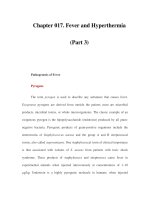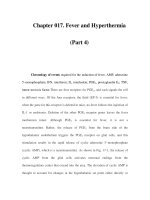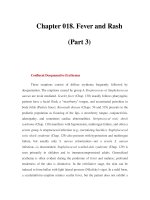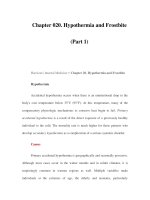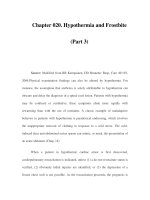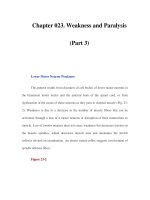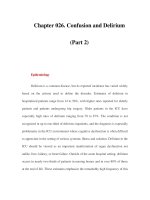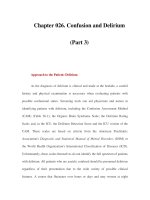Chapter 071. Vitamin and Trace Mineral Deficiency and Excess (Part 3) potx
Bạn đang xem bản rút gọn của tài liệu. Xem và tải ngay bản đầy đủ của tài liệu tại đây (128.46 KB, 6 trang )
Chapter 071. Vitamin and Trace Mineral
Deficiency and Excess
(Part 3)
Thiamine (Vitamin B
1
)
Thiamine was the first B vitamin to be identified and is therefore also
referred to as vitamin B
1
. Thiamine functions in the decarboxylation of α-
ketoacids, such as pyruvate α-ketoglutarate, and branched-chain amino acids and
thus is a source of energy generation. In addition, thiamine pyrophosphate acts as
a coenzyme for a transketolase reaction that mediates the conversion of hexose
and pentose phosphates. It has also been postulated that thiamine plays a role in
peripheral nerve conduction, although the exact chemical reactions underlying this
function are unknown.
Food Sources
The median intake of thiamine in the United States from food alone is 2
mg/d. Primary food sources for thiamine include yeast, organ meat, pork, legumes,
beef, whole grains, and nuts. Milled rice or grains contain little thiamine, if any.
Thiamine deficiency is therefore more common in cultures that rely heavily on a
rice-based diet. Tea, coffee (regular and decaffeinated), raw fish, and shellfish
contain thiaminases, which can destroy the vitamin. Thus, drinking large amounts
of tea or coffee can theoretically lower thiamine body stores.
Deficiency
Most dietary deficiency of thiamine worldwide is the result of poor dietary
intake. In Western countries, the primary causes of thiamine deficiency are
alcoholism and chronic illness, such as cancer. Alcohol interferes directly with the
absorption of thiamine and with the synthesis of thiamine pyrophosphate.
Thiamine should always be replenished when refeeding a patient with alcoholism,
as carbohydrate repletion without adequate thiamine can precipitate acute thiamine
deficiency. Other at-risk populations are women with prolonged hyperemesis
gravidarum and anorexia, patients with an overall poor nutritional status on
parenteral glucose, and patients on chronic diuretic therapy due to increased
urinary thiamine losses. Maternal thiamine deficiency can lead to infantile beriberi
in breast-fed children. Thiamine deficiency should also be considered in the
setting of motor vehicle accidents associated with head injury.
Thiamine deficiency in its early stage induces anorexia and nonspecific
symptoms (e.g., irritability, decrease in short-term memory). Prolonged thiamine
deficiency causes beriberi, which is classically categorized as wet or dry, although
there is considerable overlap. In either form of beriberi, patients may complain of
pain and paresthesia. Wet beriberi presents primarily with cardiovascular
symptoms, due to impaired myocardial energy metabolism and dysautonomia, and
can occur after 3 months of a thiamine-deficient diet. Patients present with an
enlarged heart, tachycardia, high-output congestive heart failure, peripheral
edema, and peripheral neuritis. Patients with dry beriberi present with a symmetric
peripheral neuropathy of the motor and sensory systems with diminished reflexes.
The neuropathy affects the legs most markedly, and patients have difficulty rising
from a squatting position.
Alcoholic patients with chronic thiamine deficiency may also have central
nervous system (CNS) manifestations known as Wernicke's encephalopathy,
consisting of horizontal nystagmus, ophthalmoplegia (due to weakness of one or
more extraocular muscles), cerebellar ataxia, and mental impairment (Chap. 387).
When there is an additional loss of memory and a confabulatory psychosis, the
syndrome is known as Wernicke-Korsakoff syndrome. Despite the typical clinical
picture and history, Wernicke-Korsakoff syndrome is underdiagnosed.
The laboratory diagnosis of thiamine deficiency is usually made by a
functional enzymatic assay of transketolase activity measured before and after the
addition of thiamine pyrophosphate. A >25% stimulation by the addition of
thiamine pyrophosphate (an activity coefficient of 1.25) is taken as abnormal.
Thiamine or the phosphorylated esters of thiamine in serum or blood can also be
measured by high-performance liquid chromatography (HPLC) to detect
deficiency.
Figure 71-1
The structures and principal functions of vitamins associated with
human disorders.
